|

Home
What's New?
SEARCH the
Gentian Research Network
and
Rutgers University:
GENTIANS
Classification (newest)
List of genera
List by tribe
Gentian characteristics
Gentianales
What are gentians?
Photo gallery
RESEARCH
Research projects
People, addresses
Literature, publications
Links
Add info to
this site
TOPICS
Anatomy
Classification
Common names
Ecology - Natural history
Endangered species
Ethnobotany - Uses
Gentian violet
Horticulture
Who eats gentians?
Morphology
Phylogeny
for kids!
GEOGRAPHY
Floras
Latin America
North America
TRIBES
Chironieae
Exaceae
Gentianeae
Helieae
Potalieae
Saccifolieae
_____________________
Information in other languages:





_____________________
This page
is maintained
by Dr.
Lena
Struwe
(e-mail),
and hosted by
Rutgers University, USA
Credits
updated: 01/19/11
| |
|
Comical gentians
by Guilhem Mansion |
|

In his free time, Guilhem
Mansion draws gentians to explain how they were given their names (sort
of). These are all European species of gentians. The text on the
comics and associated text have been translated from the original French.
Read more about
Gentiana (photos)
and Gentianella (photos)
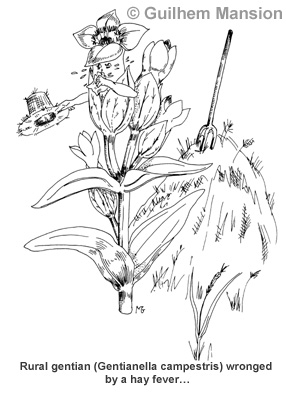
Gentianella campestris
This Gentianella (note
the fringed appendices
at the base of the corolla lobes) is common in mountain fields and
pastures, particularly
during the harvest period. |
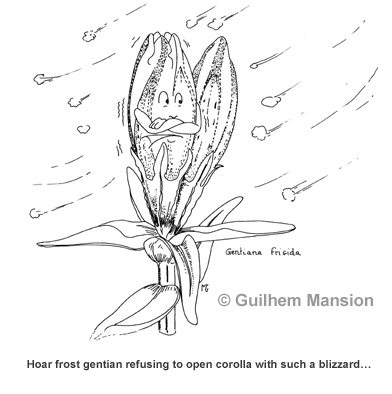
Gentiana frigida
The plant is
encountered on stony slopes and on siliceous rocks, at high altitudes
in the Alps (from Austria to Bulgaria). When climate conditions are
favorable, one can observe the full opening of the corolla.
|

Gentiana bavarica
Gentiana
bavarica, a common gentian in the
Alps, is rather bad-named. The species was first described in Austria
and not in the Bavarian
region of Germany, nor in Munich where a
world-famous beer festival occurs every year. |
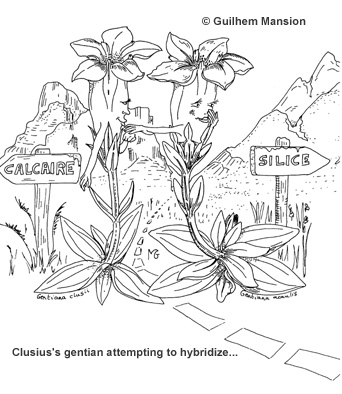
Gentiana clusii and G. acaulis
The Clusius’
gentian (Gentiana clusii) is a plant growing on calcareous
soils whereas its close relative, the Koch’s gentian (Gentiana
acaulis) occurs on silicate. In some intermediate geological
places of the Alps and Jura (near Neuchâtel), both the species may
grow together producing hybrids.
|
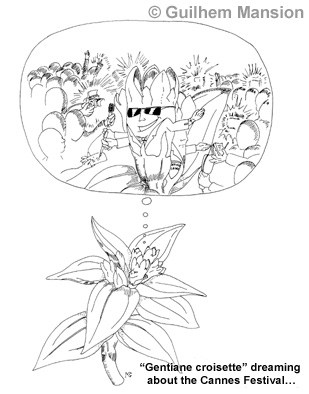
Gentiana cruciata
The French vernacular name of
Gentiana
cruciata is “gentiane croisette”, due to the opposite-decussate
leaves giving the general impression of a cross. La Croisette is a
famous place in Cannes where the Festival occurs.
|
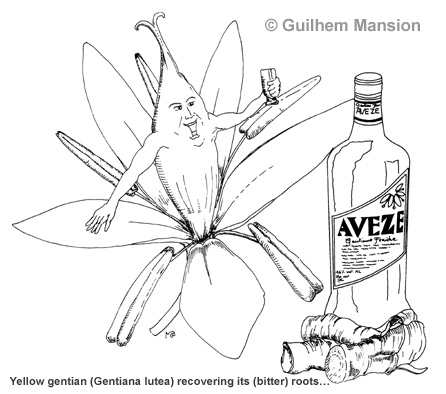
Gentiana
lutea
The yellow gentian is one
of the most imposing species within Gentiana. Some individuals
are more than 2 m high. In order to support such architecture, the
underground part (roots and rhizome) is large (up to 5 kg). The
rhizome is used for its pharmacological properties (to increase
appetite and for digestive problems) and to produce very bitter
liquors.
|
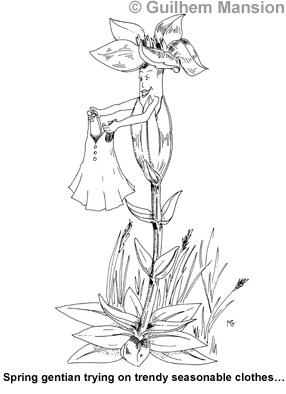
Gentiana verna
The spring gentian is early
blossoming, sometimes at low elevations (300 m), just after the snow
has melted. This species is widespread in Europe
(from Ireland to Russia) and presents many subspecies or varieties. |
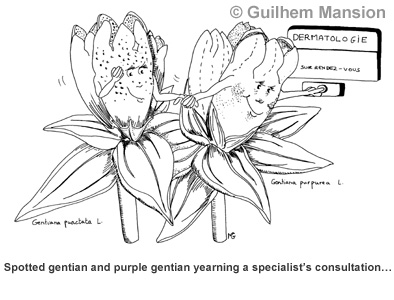
Gentiana purpurea and G. punctata
These two species occur on
siliceous soils and are characterized by some floral features. The
purple gentian has a red-wine to red-coppered corolla and exhales a
sweet fragrance (between rose and honey). The spotted gentian has a
yellowish corolla with brown to purple spots. |

© Text and all drawings
copyrighted by Guilhem Mansion. All rights reserved.
|
|








